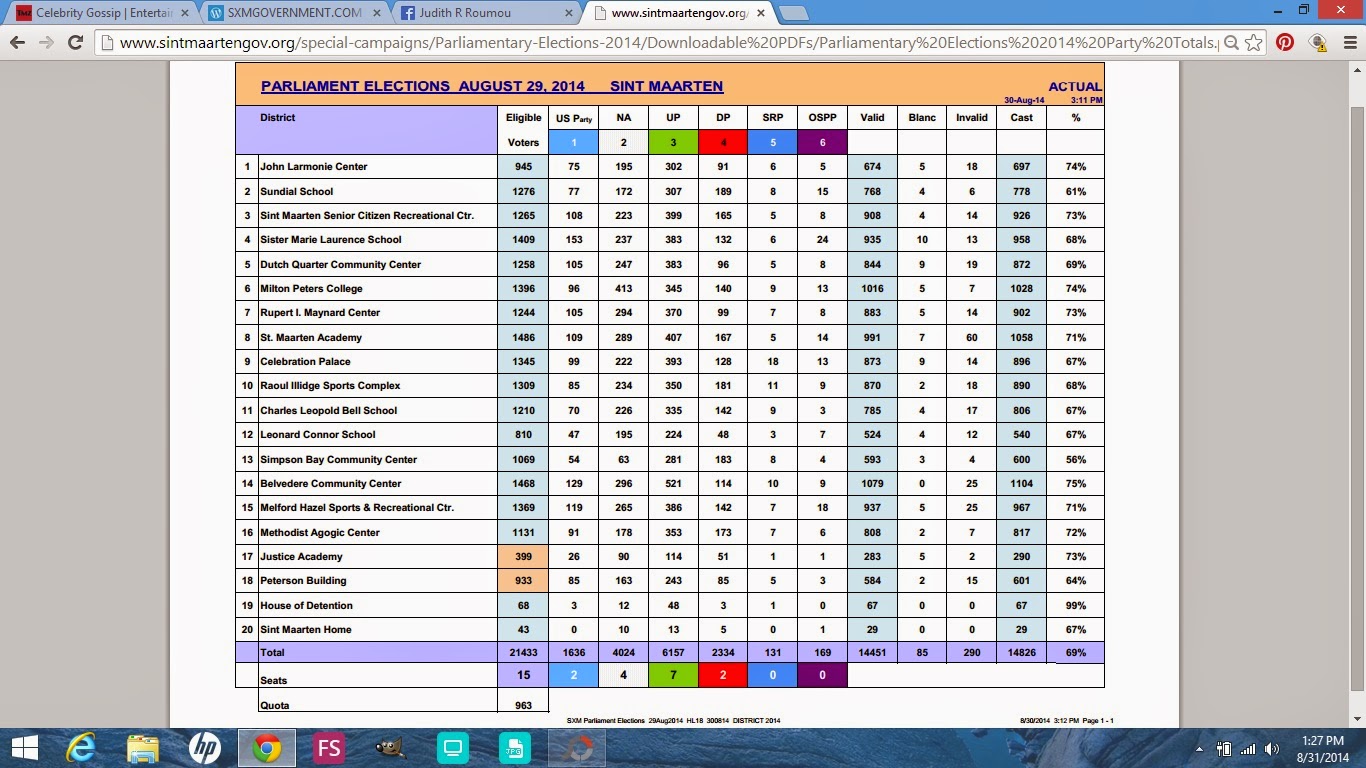The Préfecture has announced that one fatality has been attributed to the Chikungunya dengue on Friday. St Martin has over 245 registered Chikungunya cases, and the death of this 81 year old man is the first death that has been linked to the disease although the older man did already have complications from another illness.
The Préfet, the Chikungunya management committee and Agence Regional de Santé (ARS) Territorial Délégué Pascal Godefroy.
This has been the worst PR (Public Relations) nightmare for the French Tourism industry. And many locals are taking out their frustrations on the mostly unregulated increase of many illegal foreigners. Chikungunya is a West African disease which some feel have been brought into and spread by certain larger, poorer islands causing an epidemic.
St Martiners are fed up with the fact that many poorer countries, known for the worst health issues, including Cholera in the Western Hemisphere are bringing in these diseases, and destroying St Martin's great name with it.
It is now considered worldwide that St Martin is the culprit, the region of the onset of this disease, but we locals contribute these "new' mutant diseases as just the beginning as sick people from poorer countries, pour into islands like St Maarten to find work. There has to be strict immigration laws including health checks, and even stricter deportation laws when illegals are discovered and have to return.
St Maarten/ St Martin has always been the "Friendly" island, and many thousands have taken advantage of St Maarten/St Martin's open door policy and that has to stop.
The governments are encouraging these women because with the CAF government "Cheese", all these women have to do is get pregnant to collect a check.
Many times the children are not local and have no local parents, but payment agreements are made where local St Martin men, claim these children, and receive a part of their monthly checks.
These foreign CAF COWS, usually solicit men who are either mentally unstable or are hard core drug addicts. He claims to be the Father, and although its a lie, they then receive St Martin tax money to support them.
Rather than investing millions in illegitimate children who are not native St Maarteners, the government should be investing in DNA tests, which will cost them a lot less than paying out some illegal child that has NO blood ties or rights to St Maarten.
We must as St Maartener demand DNA testing on ALL these children, enough with the scams. When you go to Europe or the United States to live you are expected to live UP to their standards. The St Maarten government has allowed all these Haitians and other third world mentality people, to bring St Maarten down to THEIR level. They arrive in St Maarten, set up slums, illegal shacks as the government turn a blind eye.
To be continue.
Be on the lookout for signs and symptoms of Chikungunya Dengue which may include, incredible joint pains, fevers, chills, aches and vomiting. I will include a description below with all the sypmtom
-------------------------------------------------------------------------------------------------------------
Chikungunya
Key facts
- Chikungunya is a viral disease transmitted to humans by infected mosquitoes. It causes fever and severe joint pain. Other symptoms include muscle pain, headache, nausea, fatigue and rash.
- The disease shares some clinical signs with dengue, and can be misdiagnosed in areas where dengue is common.
- There is no cure for the disease. Treatment is focused on relieving the symptoms.
- The proximity of mosquito breeding sites to human habitation is a significant risk factor for chikungunya.
- Since 2004, chikungunya fever has reached epidemic proportions, with considerable morbidity and suffering.
- The disease occurs in Africa, Asia and the Indian subcontinent. In recent decades mosquito vectors of chikungunya have spread to Europe and the Americas. In 2007, disease transmission was reported for the first time in a localized outbreak in north-eastern Italy.
Chikungunya is a mosquito-borne viral disease first described during an outbreak in southern Tanzania in 1952. It is an RNA virus that belongs to the alphavirus genus of the family Togaviridae. The name ‘chikungunya’ derives from a word in the Kimakonde language, meaning "to become contorted" and describes the stooped appearance of sufferers with joint pain (arthralgia).
Signs and symptoms
Chikungunya is characterized by an abrupt onset of fever frequently accompanied by joint pain. Other common signs and symptoms include muscle pain, headache, nausea, fatigue and rash. The joint pain is often very debilitating, but usually lasts for a few days or may be prolonged to weeks.
Most patients recover fully, but in some cases joint pain may persist for several months, or even years. Occasional cases of eye, neurological and heart complications have been reported, as well as gastrointestinal complaints. Serious complications are not common, but in older people, the disease can contribute to the cause of death. Often symptoms in infected individuals are mild and the infection may go unrecognized, or be misdiagnosed in areas where dengue occurs.
Transmission
Chikungunya has been identified in nearly 40 countries in Asia, Africa, Europe and also in the Americas.
The virus is transmitted from human to human by the bites of infected female mosquitoes. Most commonly, the mosquitoes involved are Aedes aegypti and Aedes albopictus, two species which can also transmit other mosquito-borne viruses, including dengue. These mosquitoes can be found biting throughout daylight hours, though there may be peaks of activity in the early morning and late afternoon. Both species are found biting outdoors, but Ae. aegypti will also readily feed indoors.
After the bite of an infected mosquito, onset of illness occurs usually between four and eight days but can range from two to 12 days.
Diagnosis
Several methods can be used for diagnosis. Serological tests, such as enzyme-linked immunosorbent assays (ELISA), may confirm the presence of IgM and IgG anti-chikungunya antibodies. IgM antibody levels are highest three to five weeks after the onset of illness and persist for about two months. Samples collected during the first week after the onset of symptoms should be tested by both serological and virological methods (RT-PCR).
The virus may be isolated from the blood during the first few days of infection. Various reverse transcriptase–polymerase chain reaction (RT–PCR) methods are available but are of variable sensitivity. Some are suited to clinical diagnosis. RT–PCR products from clinical samples may also be used for genotyping of the virus, allowing comparisons with virus samples from various geographical sources.
Treatment
There is no specific antiviral drug treatment for Chikungunya. Treatment is directed primarily at relieving the symptoms, including the joint pain using anti-pyretics, optimal analgesics and fluids. There is no commercial chikungunya vaccine.
Prevention and control
The proximity of mosquito vector breeding sites to human habitation is a significant risk factor for chikungunya as well as for other diseases that these species transmit. Prevention and control relies heavily on reducing the number of natural and artificial water-filled container habitats that support breeding of the mosquitoes. This requires mobilization of affected communities. During outbreaks, insecticides may be sprayed to kill flying mosquitoes, applied to surfaces in and around containers where the mosquitoes land, and used to treat water in containers to kill the immature larvae.
For protection during outbreaks of chikungunya, clothing which minimizes skin exposure to the day-biting vectors is advised. Repellents can be applied to exposed skin or to clothing in strict accordance with product label instructions. Repellents should contain DEET (N, N-diethyl-3-methylbenzamide), IR3535 (3-[N-acetyl-N-butyl]-aminopropionic acid ethyl ester) or icaridin (1-piperidinecarboxylic acid, 2-(2-hydroxyethyl)-1-methylpropylester). For those who sleep during the daytime, particularly young children, or sick or older people, insecticide treated mosquito nets afford good protection. Mosquito coils or other insecticide vaporizers may also reduce indoor biting.
Basic precautions should be taken by people traveling to risk areas and these include use of repellents, wearing long sleeves and pants and ensuring rooms are fitted with screens to prevent mosquitoes from entering.
Disease outbreaks
Chikungunya occurs in Africa, Asia and the Indian subcontinent. Human infections in Africa have been at relatively low levels for a number of years, but in 1999-2000 there was a large outbreak in the Democratic Republic of the Congo, and in 2007 there was an outbreak in Gabon.
Starting in February 2005, a major outbreak of chikungunya occurred in islands of the Indian Ocean. A large number of imported cases in Europe were associated with this outbreak, mostly in 2006 when the Indian Ocean epidemic was at its peak. A large outbreak of chikungunya in India occurred in 2006 and 2007. Several other countries in South-East Asia were also affected. Since 2005, India, Indonesia, Thailand, Maldives and Myanmar have reported over 1.9 million cases. In 2007 transmission was reported for the first time in Europe, in a localized outbreak in north-eastern Italy. There were 197 cases recorded during this outbreak and it confirmed that mosquito-borne outbreaks by Ae. Albopictus are plausible in Europe.
More about disease vectors
Both Ae. aegypti and Ae. albopictus have been implicated in large outbreaks of chikungunya. Whereas Ae. aegypti is confined within the tropics and sub-tropics, Ae. albopictus also occurs in temperate and even cold temperate regions. In recent decades Ae. albopictus has spread from Asia to become established in areas of Africa, Europe and the Americas.
The species Ae. albopictus thrives in a wider range of water-filled breeding sites thanAe. aegypti, including coconut husks, cocoa pods, bamboo stumps, tree holes and rock pools, in addition to artificial containers such as vehicle tyres and saucers beneath plant pots. This diversity of habitats explains the abundance of Ae. albopictus in rural as well as peri-urban areas and shady city parks.
Ae. aegypti is more closely associated with human habitation and uses indoor breeding sites, including flower vases, water storage vessels and concrete water tanks in bathrooms, as well as the same artificial outdoor habitats as Ae. albopictus.
In Africa several other mosquito vectors have been implicated in disease transmission, including species of the A. furcifer-taylori group and A. luteocephalus. There is evidence that some animals, including non-primates, rodents, birds and small mammals may act as reservoirs.
WHO response
WHO responds to chikungunya by:
- formulating evidence-based outbreak management plans;
- providing technical support and guidance to countries for the effective management of cases and outbreaks;
- supporting countries to improve their reporting systems;
- providing training on clinical management, diagnosis and vector control at the regional level with some of its collaborating centres;
- publishing guidelines and handbooks for case management, vector control for Member States.
For more information contact:














































.JPG)
.JPG)
.JPG)
.JPG)
.JPG)
.JPG)
.JPG)
.JPG)
.JPG)
.JPG)
.JPG)
.JPG)
.JPG)
.JPG)
.JPG)
.JPG)
.JPG)
.JPG)
.JPG)
.JPG)
.JPG)
.JPG)
.JPG)
.JPG)
.JPG)
.JPG)
